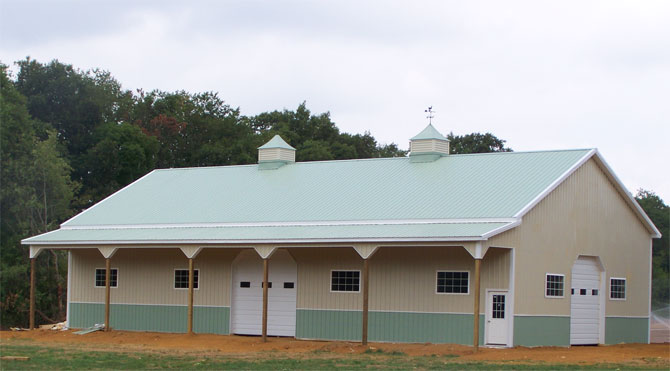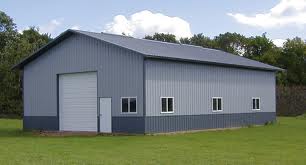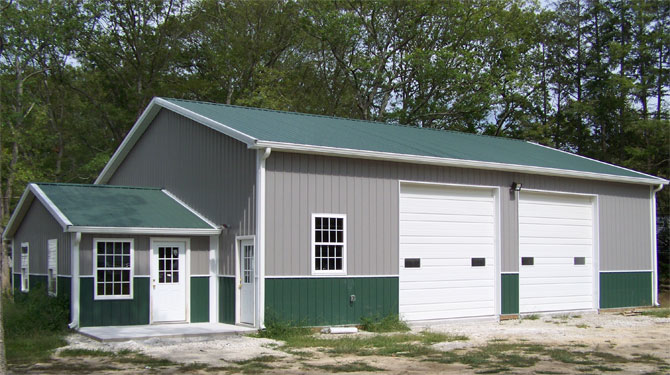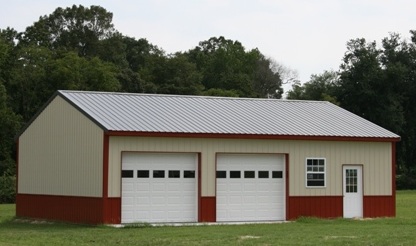US Metal Garages
Pole Barn Kits Connecticut | Pole Buildings Connecticut CT
We now carry Connecticut CT pole barn kits. We carry Connecticut CT pole buildings in many different sizes. Our metal pole barns come standard with 14 ga framing with available 12 gauge at an additional cost! Also our sheet metal comes standard with 29 gauge with 26 gauge available at an additional cost. Our sheeting is available in 13 different colors. Our Connecticut CT pole barns are great for agricultural, commercial and livestock! Our all toll free 1-877-662-9060 for more information!
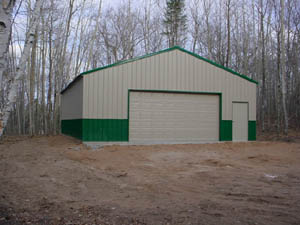
Call toll free: 1-877-662-9060
Email us: sales@mayberrymetalstructures.com
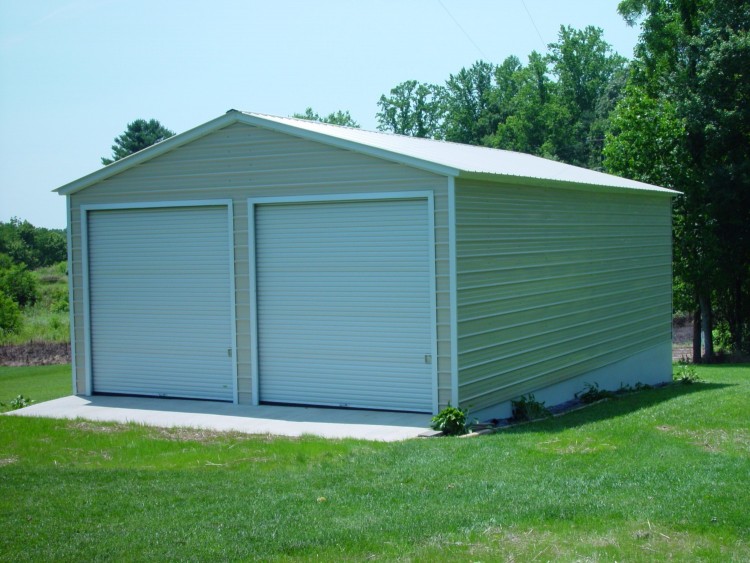
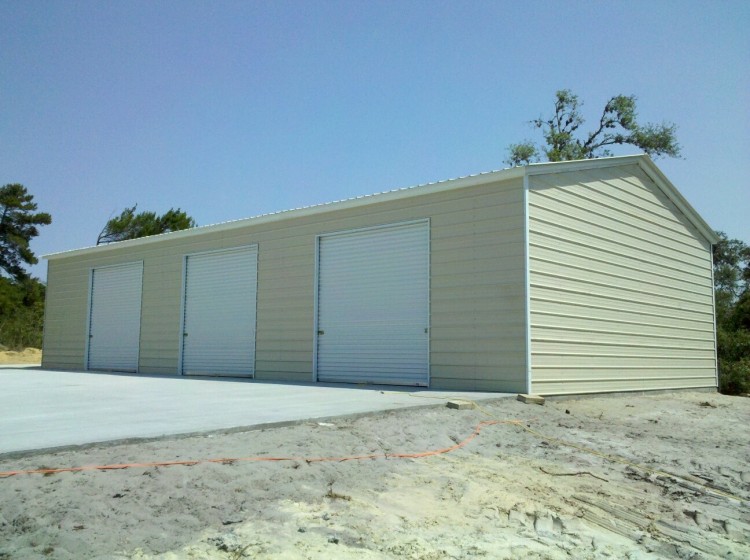
24x40x11 Vertical Roof Garage
With: (3) 10'x10' Garage Doors
(1) 36"x80" Walk in Door
24x30x11 Vertical Roof Garage
With: (2) 10'x10' Garage Doors
(1) 36" Walk in Door
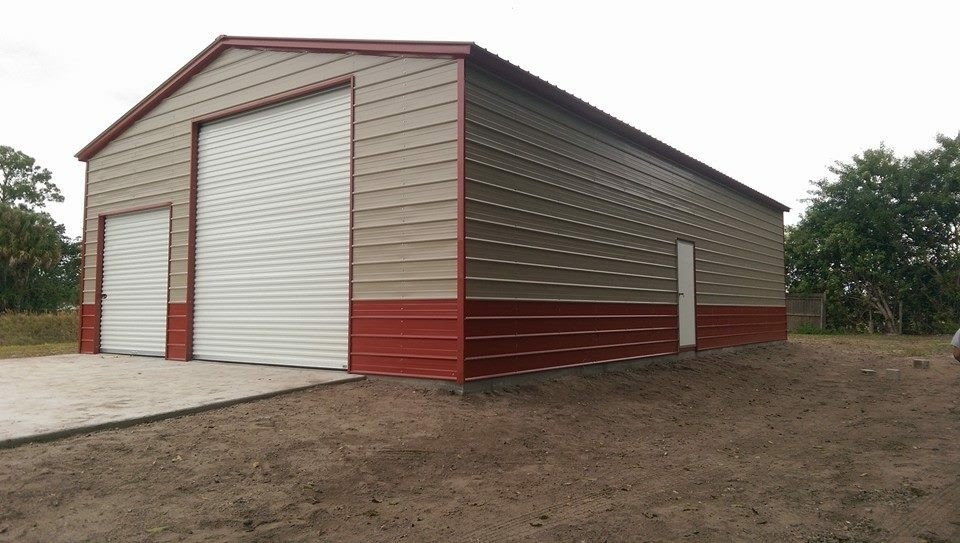
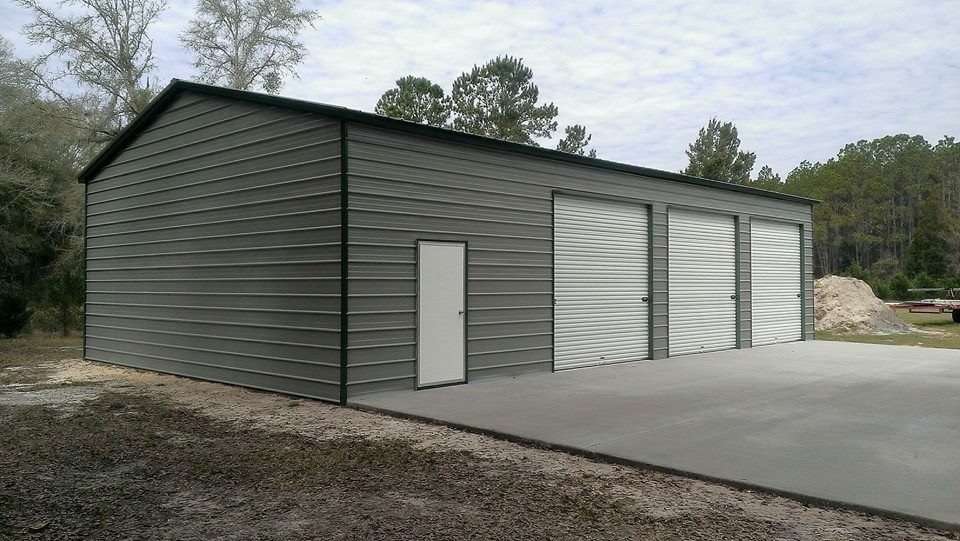
1-877-662-9060
24x45x12 Vertical Roof Garage
with: (3) 10'x10' Garage Doors
(1) 36" Walk in Door
24x40x12 Vertical Roof Garage
with: (1) 10'x10' Garage Door
(1) 6'x6' Garage Door
(1) 36" Walk in Door
1-877-662-9060
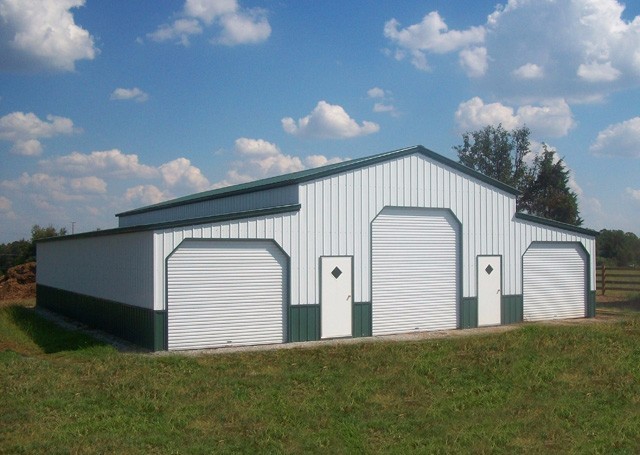
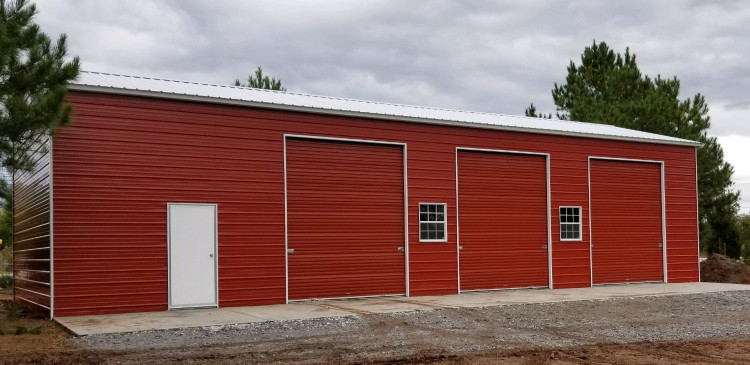
48x40x14&10 All Vertical Carolina Barn
12 & 24 & 12
30x50x12 Vertical Roof Garage
with: (3) 10'x10' Garage Doors
(1) 36"x80" Walk in Door
(2) Windows
1-877-662-9060
We sell to most of Connecticut including the following cities:
Ansonia CT, Avon CT, Baltic CT, Beacon Falls CT, Berlin CT, Bethany CT, Bethel CT, Bethlehem CT, Bloomfield CT, Blue Hills CT, Branford CT, Bridgeport CT, Bristol CT, Broad Brook CT, Brookfield CT, Brookfield Center CT, Brooklyn CT, Canaan CT, Candlewood Shores CT, Cannondale CT, Canton CT, Central Village CT, Cherry Brook CT, Cheshire CT, Chester CT, Clinton CT, Colchester CT, Collinsville CT, Coventry CT, Cromwell CT, Danbury CT, Danielson CT, Darien CT, Dayville CT, Deep River CT, Derby CT, Durham CT, East Berlin CT, East Brooklyn CT, East Canaan CT, East Granby CT, East Hampton CT, East Hartford CT, East Hartland CT, East Haven CT, East Lyme CT, East River CT, East Windsor CT, Ellington CT, Enfield CT, Essex CT, Fairfield CT, Farmington CT, Gales Ferry CT, Georgetown CT, Giants Neck CT, Glastonbury CT, Granby CT, Greenwich CT, Groton CT, Guilford CT, Haddam CT, Hamden CT, Hartford CT, Harwinton CT, Hazardville CT, Higganum CT, Indian Neck CT, Ivoryton CT, Jewett City CT, Kensington CT, Kent CT, Lakeville CT, Madison CT, Manchester CT, Meriden CT, Middlebury CT, Middletown CT, Milford CT, Monroe CT, Moosup CT, Mystic CT, Naugatuck CT, New Branford CT, New Britain CT, New Canaan CT, New Fairfield CT, New Hartford CT, New Haven CT, Newington CT, New London CT, New Milford CT, New Preston CT, Niantic CT, Norfolk CT, North Branford CT, Northford CT, North Haven CT, Norwalk CT, Norwich CT, Oakville CT, Old Saybrook CT, Orange CT, Oxford CT, Pawcatuck CT, Pine Bridge CT, Plainfield CT, Plainville CT, Plantsville CT, Pleasure Beach CT, Plymouth CT, Poquonock CT, Poquonock Bridge CT, Portland CT, Prospect CT, Putnam CT, Quaker Hill CT, Quinebaug CT, Ridgefield CT, Rocky Hill CT, Salisbury CT, Sandy Hook CT, Seymour CT, Sharon CT, Shelton CT, Simsbury CT, Somers CT, Somersville CT, Southbury CT, South Glastonbury CT, Southington CT, South Windham CT, South Windsor CT, South Woodstock CT, Stafford Springs CT, Stamford CT, Stonington CT, Storrs CT, Stratford CT, Suffield CT, Tariffville CT, Terryville CT, Thomaston CT, Tolland CT, Torrington CT, Trumbull CT, Uncasville CT, Unionville CT, Upper Stepney CT, Vernon CT, Wallingford CT, Waterbury CT, Waterford CT, Watertown CT, Wauregan CT, Weatogue CT, Westbrook CT, West Hartford CT, West Haven CT, West Mystic CT, Weston CT, Westport CT, West Simsbury CT, Wethersfield CT, Willimantic CT, Wilton CT, Windsor CT, Windsor Locks CT, Winsted CT, Wolcott CT, Woodbridge CT, Woodbury CT and Woodmont CT!
The Ultimate Guide to Pole Barns in Connecticut: Unveiling the Secrets to Building Your Perfect Structure
Connecticut, with its diverse climate and specific building regulations, presents unique challenges when it comes to constructing pole barns. Our expert tips and insights will help you navigate through these challenges, ensuring you make informed decisions every step of the way. From selecting the right materials and foundation to optimizing space utilization and enhancing the energy efficiency of your pole barn, we leave no stone unturned in providing you with the knowledge you need to build your dream structure.
Whether you're a seasoned builder or a first-time DIY enthusiast, this guide is for you. So, grab a cup of coffee, sit back, and let's embark on this exciting journey of building the perfect pole barn in Connecticut!
Constructing a pole barn in Connecticut offers numerous advantages that make it an attractive option for various applications. One of the primary benefits is the versatility of these structures. Pole barns can be designed and customized to serve a wide range of purposes, from agricultural storage and workshops to garages and even residential spaces. This flexibility allows you to tailor the building to your specific needs, ensuring that it perfectly fits your requirements.
Another significant advantage of pole barns is their cost-effectiveness. Compared to traditional stick-built structures, pole barns are generally more affordable to construct, thanks to their simpler design and the use of fewer materials. This makes them an excellent choice for those looking to maximize their budget while still obtaining a durable and functional building. Additionally, the ease of construction and the ability to perform much of the work yourself, if desired, can further reduce the overall cost of the project.
The durability and longevity of pole barns are also noteworthy benefits. These structures are designed to withstand the unique weather conditions and environmental challenges found in Connecticut, such as high winds, heavy snowfall, and extreme temperature fluctuations. With proper maintenance and care, a well-constructed pole barn can serve you and your family or business for decades, providing a reliable and long-lasting solution to your storage, workshop, or agricultural needs.
When planning to build a pole barn in Connecticut, it's essential to carefully consider several key factors to ensure the success and longevity of your project. One of the primary considerations is the local climate and weather patterns. Arkansas is known for its diverse weather conditions, ranging from hot and humid summers to cold and snowy winters. Understanding the specific challenges posed by the local climate, such as wind loads, snow accumulation, and rainfall patterns, will help you design a pole barn that can withstand these environmental stresses.
Another crucial factor to consider is the intended use of your pole barn. Will it be used for agricultural purposes, such as storing farm equipment or housing livestock? Or will it serve as a workshop, a garage, or even a living space? Knowing the specific purpose of your pole barn will guide you in selecting the appropriate size, layout, and features to meet your needs. For instance, if you plan to use the pole barn for storing large machinery, you'll need to ensure that the structure can accommodate the necessary clearances and weight-bearing capacity.
Site selection is also a critical factor when building a pole barn in Connecticut. The location of your pole barn can have a significant impact on its functionality, accessibility, and compliance with local regulations. Consider factors such as the terrain, soil conditions, proximity to utilities, and any potential zoning or building restrictions in the area. Choosing the right location can maximize the efficiency and long-term viability of your pole barn project.
Selecting the ideal location for your pole barn in Connecticut is a crucial step in the planning process. The site you choose can have a significant impact on the overall functionality, accessibility, and compliance of your structure. When evaluating potential locations, there are several key factors to consider.
First and foremost, assess the terrain and soil conditions of the site. Pole barns require a stable and level foundation, so it's essential to choose a location with suitable soil characteristics that can support the weight of the structure. Avoid areas with poor drainage or high water tables, as these can lead to structural issues over time.
Another important consideration is the proximity to utilities. Ideally, your pole barn should be situated in close proximity to existing power, water, and sewer lines, if available. This can simplify the installation process and reduce the overall cost of the project. Additionally, consider the accessibility of the site, ensuring that it can be easily reached by vehicles and equipment necessary for the construction and ongoing use of the pole barn.
Compliance with local zoning and building regulations is also a crucial factor when selecting the location for your pole barn. Research the applicable laws and regulations in your area, as they may dictate the minimum setbacks from property lines, the maximum height or size of the structure, and any other specific requirements. Choosing a site that aligns with these regulations can help streamline the permitting process and avoid potential conflicts down the line.
Designing your perfect pole barn in Connecticut requires careful consideration of various factors to ensure that the structure meets your specific needs and complies with local regulations. One of the first steps in the design process is to determine the overall size and layout of the pole barn. Consider the intended use of the space, the amount of storage or workspace required, and any future expansion plans you may have.
When it comes to the layout, think about the flow of traffic and the placement of doors, windows, and any interior walls or partitions. Efficient use of space is crucial, so plan the design to maximize the functionality of the pole barn. If you're using the structure for agricultural purposes, such as housing livestock or storing farm equipment, you'll need to ensure that the layout accommodates the necessary clearances and access points.
The architectural style of your pole barn is another important design element to consider. While pole barns are often associated with a utilitarian aesthetic, you can incorporate design elements that complement the surrounding landscape or your personal preferences. This can include the choice of siding materials, roof styles, and even the inclusion of decorative features or accents.
Energy efficiency is also a key consideration in the design of your pole barn. Factors such as insulation, ventilation, and the placement of windows and doors can significantly impact the temperature regulation and overall energy performance of the structure. By incorporating energy-efficient design elements, you can not only reduce your operating costs but also contribute to a more sustainable and environmentally friendly building.
Welcome to the ultimate guide to pole barns in Connecticut! Whether you plan to use it for agricultural purposes, as a workshop, or even as a storage space, building the perfect pole barn requires knowledge and careful planning. In this comprehensive guide, we'll unveil the secrets to creating your ideal structure that not only meets your needs but also stands the test of time.
Connecticut, with its diverse climate and specific building regulations, presents unique challenges when it comes to constructing pole barns. Our expert tips and insights will help you navigate through these challenges, ensuring you make informed decisions every step of the way. From selecting the right materials and foundation to optimizing space utilization and enhancing the energy efficiency of your pole barn, we leave no stone unturned in providing you with the knowledge you need to build your dream structure.
Whether you're a seasoned builder or a first-time DIY enthusiast, this guide is for you. So, grab a cup of coffee, sit back, and let's embark on this exciting journey of building the perfect pole barn in Connecticut!
Benefits of building a pole barn
Constructing a pole barn in Connecticut offers numerous advantages that make it an attractive option for various applications. One of the primary benefits is the versatility of these structures. Pole barns can be designed and customized to serve a wide range of purposes, from agricultural storage and workshops to garages and even residential spaces. This flexibility allows you to tailor the building to your specific needs, ensuring that it perfectly fits your requirements.
Another significant advantage of pole barns is their cost-effectiveness. Compared to traditional stick-built structures, pole barns are generally more affordable to construct, thanks to their simpler design and the use of fewer materials. This makes them an excellent choice for those looking to maximize their budget while still obtaining a durable and functional building. Additionally, the ease of construction and the ability to perform much of the work yourself, if desired, can further reduce the overall cost of the project.
The durability and longevity of pole barns are also noteworthy benefits. These structures are designed to withstand the unique weather conditions and environmental challenges found in Connecticut, such as high winds, heavy snowfall, and extreme temperature fluctuations. With proper maintenance and care, a well-constructed pole barn can serve you and your family or business for decades, providing a reliable and long-lasting solution to your storage, workshop, or agricultural needs.
Factors to consider before building a pole barn in Connecticut
When planning to build a pole barn in Connecticut, it's essential to carefully consider several key factors to ensure the success and longevity of your project. One of the primary considerations is the local climate and weather patterns. Arkansas is known for its diverse weather conditions, ranging from hot and humid summers to cold and snowy winters. Understanding the specific challenges posed by the local climate, such as wind loads, snow accumulation, and rainfall patterns, will help you design a pole barn that can withstand these environmental stresses.
Another crucial factor to consider is the intended use of your pole barn. Will it be used for agricultural purposes, such as storing farm equipment or housing livestock? Or will it serve as a workshop, a garage, or even a living space? Knowing the specific purpose of your pole barn will guide you in selecting the appropriate size, layout, and features to meet your needs. For instance, if you plan to use the pole barn for storing large machinery, you'll need to ensure that the structure can accommodate the necessary clearances and weight-bearing capacity.
Site selection is also a critical factor when building a pole barn in Connecticut. The location of your pole barn can have a significant impact on its functionality, accessibility, and compliance with local regulations. Consider factors such as the terrain, soil conditions, proximity to utilities, and any potential zoning or building restrictions in the area. Choosing the right location can maximize the efficiency and long-term viability of your pole barn project.
The Advantages of Connecticut Metal Pole Barns: A Complete Guide
When it comes to durable, cost-effective, and versatile structures, metal pole barns from Connecticut stand out as a top choice. From agricultural purposes to commercial and residential use, the advantages of metal pole barns are vast and varied. In this complete guide, we'll delve into the myriad benefits these structures offer, from their customizable designs to their energy efficiency and low maintenance requirements.
The sturdy construction of Connecticut metal pole barns provides optimal protection against the elements, ensuring long-term reliability and resilience. Additionally, their open-span design allows for spacious interiors without the need for intrusive support beams. This feature makes them ideal for accommodating a wide range of activities and storage needs.
Whether you're considering a new building project or contemplating upgrading an existing structure, understanding the advantages of metal pole barns is essential for informed decision-making. Join us as we explore everything you need to know about these versatile and dependable constructions.
Understanding metal pole barns from Connecticut
Metal pole barns from Connecticut, also known as post-frame buildings, are constructed using large poles or posts buried in the ground or secured to a concrete foundation. These sturdy poles support the roof and walls, creating a durable and reliable structure. The open-span design of metal pole barns eliminates the need for interior support walls or columns, providing a spacious and versatile interior space.
Metal pole barns can be customized to suit a wide range of needs, from agricultural storage and equestrian facilities to workshops, retail spaces, and residential housing. Their versatility and cost-effectiveness make them a popular choice for various applications.
Metal pole barns are distinguished by their simple yet effective construction, which prioritizes functionality and durability. This straightforward building method contributes to their affordability and ease of construction, making them an attractive option for many property owners.
Choosing the right location for your pole barn
Selecting the ideal location for your pole barn in Connecticut is a crucial step in the planning process. The site you choose can have a significant impact on the overall functionality, accessibility, and compliance of your structure. When evaluating potential locations, there are several key factors to consider.
First and foremost, assess the terrain and soil conditions of the site. Pole barns require a stable and level foundation, so it's essential to choose a location with suitable soil characteristics that can support the weight of the structure. Avoid areas with poor drainage or high water tables, as these can lead to structural issues over time.
Another important consideration is the proximity to utilities. Ideally, your pole barn should be situated in close proximity to existing power, water, and sewer lines, if available. This can simplify the installation process and reduce the overall cost of the project. Additionally, consider the accessibility of the site, ensuring that it can be easily reached by vehicles and equipment necessary for the construction and ongoing use of the pole barn.
Compliance with local zoning and building regulations is also a crucial factor when selecting the location for your pole barn. Research the applicable laws and regulations in your area, as they may dictate the minimum setbacks from property lines, the maximum height or size of the structure, and any other specific requirements. Choosing a site that aligns with these regulations can help streamline the permitting process and avoid potential conflicts down the line.
Designing your perfect pole barn
Designing your perfect pole barn in Connecticut requires careful consideration of various factors to ensure that the structure meets your specific needs and complies with local regulations. One of the first steps in the design process is to determine the overall size and layout of the pole barn. Consider the intended use of the space, the amount of storage or workspace required, and any future expansion plans you may have.
When it comes to the layout, think about the flow of traffic and the placement of doors, windows, and any interior walls or partitions. Efficient use of space is crucial, so plan the design to maximize the functionality of the pole barn. If you're using the structure for agricultural purposes, such as housing livestock or storing farm equipment, you'll need to ensure that the layout accommodates the necessary clearances and access points.
The architectural style of your pole barn is another important design element to consider. While pole barns are often associated with a utilitarian aesthetic, you can incorporate design elements that complement the surrounding landscape or your personal preferences. This can include the choice of siding materials, roof styles, and even the inclusion of decorative features or accents.
Energy efficiency is also a key consideration in the design of your pole barn. Factors such as insulation, ventilation, and the placement of windows and doors can significantly impact the temperature regulation and overall energy performance of the structure. By incorporating energy-efficient design elements, you can not only reduce your operating costs but also contribute to a more sustainable and environmentally friendly building.

